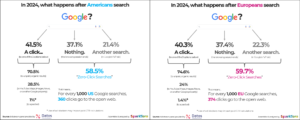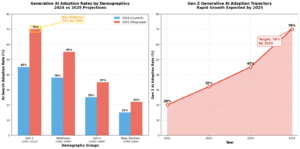Why Firms Should Focus on GEO Along with SEO
Aug 5, 2025 | 3 Min Read | 1000 Views

1. Introduction
The digital landscape is undergoing a profound transformation with the rise of artificial intelligence in search technology. Search Engine Optimization (SEO) has long been the cornerstone of online visibility, helping websites climb rankings on platforms like Google and Bing. However, a new paradigm is emerging- Generative Engine Optimization (GEO), which focuses on optimizing content for AI-driven search engines that generate direct answers rather than simply listing websites.
SEO is the traditional practice of optimizing website content to rank higher in search engine results pages (SERPs) through strategies like keyword optimization, backlink building, and technical website improvements. In contrast, GEO is the emerging practice of structuring content so that AI-driven engines like ChatGPT, Perplexity, Gemini, or Bing Chat cite, summarize, or link to your brand in their AI-generated responses.
This transformation is happening rapidly. Current research shows 58.5% of US Google searches and 59.7% of EU searches end in zero-click experiences. Meanwhile, generative AI adoption doubled to 65% in 2024, with Google’s AI Overviews appearing on 86.83% of search queries, fundamentally reshaping digital visibility strategies.
As businesses navigate this evolving search landscape, understanding the differences between SEO and GEO—and developing strategies that leverage both—will be critical to maintaining online visibility and driving customer engagement.

2.Differences Between SEO and GEO
Traditional Search Engine Algorithms vs. Generative AI Engines
Traditional search engines like Google use algorithms focused primarily on ranking websites based on factors such as keyword relevance, backlink quality, and user engagement metrics. These engines present users with a list of links to websites that might answer their query, requiring users to click through and extract the information they need.
Generative AI engines, on the other hand, leverage large language models (LLMs) to directly synthesize answers from multiple sources. As the arXiv paper “GEO: Generative Engine Optimization” explains: “While widely used for Search Engine Optimization, we find that traditional SEO methods are not directly applicable to Generative Engines. This is because, unlike traditional search engines, the generative model in generative engines is not limited to simple keyword matching” arXiv.
These fundamental differences in technology create very different landscapes for optimization:
Changes in User Intent and Content Discovery
User behavior and expectations are also changing dramatically. Traditional search engines trained users to scan through lists of results and click on multiple options until they found what they needed. Generative search engines are training users to expect immediate, comprehensive answers without leaving the search interface.
“Unlike SEO, which tries to earn a click, GEO is about becoming the answer. SEO focuses on visibility. GEO focuses on influence,” notes ePublishing.
This shift has major implications for content discovery. In the SEO-dominated world, users discovered content primarily by clicking through from search results. In the GEO-dominated world, users may never visit a website but will still consume its content through AI-generated summaries and citations.
3.Importance of GEO
Visibility in AI-Generated Answers and Summaries
As AI platforms increasingly mediate the relationship between users and content, visibility within AI-generated answers becomes crucial. When a user asks a question to ChatGPT or uses Google’s AI Overview feature, only a handful of sources get cited in the response—making this new “position zero” the prime digital real estate.
Research demonstrates that GEO methods can significantly improve this visibility. According to the arXiv study, “We demonstrate that our proposed Generative Engine Optimization methods can boost visibility by up to 40% on diverse queries” arXiv.
For businesses, this means that without effective GEO strategies, their content may become invisible to users even if they rank well in traditional search, as users increasingly bypass traditional search results in favor of AI-generated answers.
GEO’s Influence on Brand Authority and Trust
When an AI system cites a brand as a source in its generated response, it implicitly confers authority and trustworthiness to that source. This represents a fundamental shift in how authority is established online.
In traditional SEO, users might judge a website’s credibility after clicking through, based on design, content quality, and other factors. In AI-mediated search, the very fact that an AI platform has selected a source to cite becomes a powerful signal of credibility to users.
As Connected Markets notes, “For e-commerce, success hinges on product discoverability and trust. As consumers increasingly rely on AI assistants to recommend products, brands must ensure their offerings are not only visible but also accurately described” Zen Agency.
Reaching New Audiences Through AI Content Channels
GEO opens up entirely new channels for reaching audiences who may never encounter traditional search results. As voice assistants, AI chatbots, and other AI-powered interfaces become more prevalent, optimizing for these platforms becomes essential for comprehensive digital reach.
Data shows that different demographic groups are adopting AI search at different rates, with 70% of Gen Z expected to use generative AI by 2025 Zen Agency. By implementing strong GEO strategies, businesses can connect with these audiences through the technologies they prefer to use.

4.Synergy: GEO and SEO
Creating a Comprehensive Digital Presence
Rather than viewing SEO and GEO as competing strategies, forward-thinking companies are recognizing the synergy between them. Together, they create a comprehensive digital presence that captures visibility across both traditional and AI-powered search interfaces.
Foundation Inc. explains this complementary relationship: “The worlds of SEO and GEO are not mutually exclusive but complementary. Understanding the nuances between these two strategies is crucial for anyone looking to maximize their online visibility” Foundation Inc.
Businesses that focus exclusively on one approach risk missing significant portions of their potential audience. Case studies demonstrate that abandoning traditional SEO entirely for GEO often leads to overall traffic decline, as Google still remains the dominant traffic source for many businesses Zen Agency.
Leveraging Data from Both Approaches
One of the most powerful aspects of implementing both SEO and GEO strategies is the ability to leverage data from both approaches to enhance overall content optimization.
SEO data provides insights into user queries, click patterns, and engagement metrics. GEO data reveals how AI systems interpret and cite content, which sources they consider authoritative, and which content formats perform best in generated responses.
By analyzing both data sets together, businesses can identify:
- Content gaps that need to be addressed
- Topics where they have authority in traditional search but are missing from AI responses
- Opportunities to restructure existing content for better AI visibility
- New content types that could perform well across both channels
Future-Proofing Marketing Efforts
Perhaps most importantly, implementing both SEO and GEO strategies helps businesses future-proof their marketing efforts as the search landscape continues to evolve.
“Complementing your SEO with GEO future-proofs your strategy to better adapt to digital advancements, solidifying your brand’s presence and visibility” Ansira.
The balance between traditional and AI-powered search will likely continue to shift in the coming years. By maintaining expertise in both areas, businesses can adapt quickly to these changes without sacrificing visibility in either channel.
5.Implementation Considerations
Adapting Content for Generative Engines
Successfully optimizing for generative engines requires specific content adaptations beyond traditional SEO practices:
- Direct Answer Format:AI tools prioritize user intent. Content should be structured with titles, headers, and introductions that match real search phrasing and user intent Growth Marketing Pro.
- Citation Optimization:Strategically incorporating references from authoritative and credible sources significantly increases content’s trustworthiness in the eyes of AI systems Foundation Inc.
- Statistical Integration:Embedding relevant data points within content provides concrete evidence that supports the information, making it more likely to be cited by AI engines seeking factual support Foundation Inc.
- Schema Markup:Implementing comprehensive schema markup helps AI systems better understand and contextualize content, establishing clear relationships between entities and concepts Zen Agency.
- Content Freshness:AI uses signals such as publish date and frequency of updates to prioritize data used to generate answers, making regular content updates essential Improvado.
Real-world case studies demonstrate the effectiveness of these approaches. A mid-sized fashion retailer implemented a comprehensive GEO strategy focusing on structured product data and detailed FAQ content, resulting in a 32% increase in AI-referred traffic within three months Zen Agency.
Monitoring Performance Across Platforms
Tracking performance across both traditional search and AI platforms requires new measurement frameworks and tools:
Key GEO KPIs to Monitor:
- Keyword and Brand Visibility:Tracking how often your brand is cited as a source in AI-generated responses.
- AI Search Engine Referral:Monitoring traffic from AI-driven search platforms, which requires specialized tracking since “AI traffic often gets misclassified in analytics, appearing as ‘Direct’ traffic or mixed with other ‘Referral’ traffic” Empathy First Media.
- AI Overviews:Understanding how often your content appears in AI overviews that summarize content directly in search results.
- On-Site Engagement Metrics:Comparing engagement metrics for AI-sourced visitors versus traditional search visitors.
- Conversions, Leads & Revenue:Setting up goal tracking to attribute conversions to AI-generated traffic.
- Content Authority:Monitoring domain authority and external links as indicators of how AI engines might perceive your content’s reliability Obility B2B.
Implementing server-level tracking is crucial for capturing AI crawler interactions, as traditional JavaScript-based analytics miss these visits entirely Salesforce.

6.Conclusion
The digital search landscape is undergoing a fundamental transformation with the rise of AI-powered search interfaces. While SEO remains essential for visibility in traditional search engines, GEO is rapidly becoming equally important for ensuring content is discovered, cited, and trusted in AI-generated responses.
The most successful digital strategies will leverage both approaches, creating content that performs well across all search interfaces while implementing the technical optimizations required by each platform. This comprehensive approach ensures maximum visibility, regardless of how users choose to search.
As the distribution of search volume continues to shift between traditional and AI-powered interfaces, businesses that have invested in both SEO and GEO will be best positioned to maintain consistent visibility and engagement. The future belongs to those who recognize that these strategies are not competing approaches but complementary components of a holistic digital presence.
By starting GEO implementation now—while maintaining strong SEO practices—firms can future-proof their digital strategy and ensure their content remains discoverable, regardless of how search technology evolves in the coming years.
References:
- 1.Aggarwal, P., Murahari, V., Rajpurohit, T., Kalyan, A., Narasimhan, K., & Deshpande, A. (2024). GEO: Generative Engine Optimization. arXiv.
- 2.Sharma, A., & Dhiman, M.P. The Impact of AI-Powered Search on SEO: The Emergence of Answer Engine Optimization. ResearchGate.
- 3.SEO.AI (2025). Generative Engine Optimization (GEO) vs Search Engine Optimization (SEO).
- 4.Foundation Inc. SEO vs GEO: Search Engine Optimization vs Generative Engine Optimization.
- 5.ePublishing (2025). SEO vs GEO: What Is Generative Engine Optimization and Why It Matters.
- 6.Search Engine Land (2024). What is generative engine optimization (GEO)?
- 7.Search Engine Land (2025). How to integrate GEO with SEO.
- 8.Writesonic. GEO vs SEO: What’s The Difference?
- 9.Backlinko (2025). Generative Engine Optimization (GEO): How to Win in AI Search.
- 10.SparkToro Study(2024)










